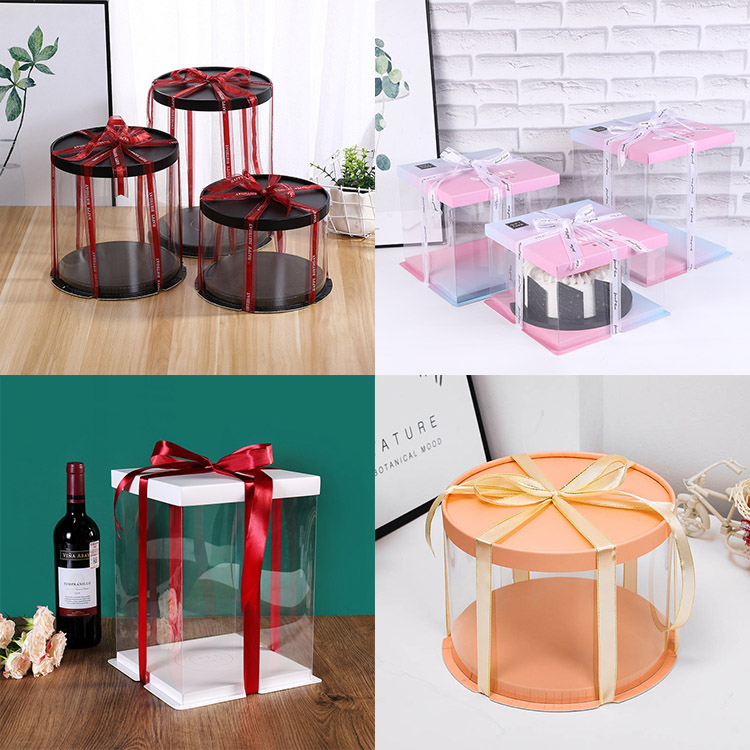Common materials for transparent cake boxes
2024/01/08
Transparent cake boxes are crafted from a variety of materials, each carefully chosen to offer optimal clarity, durability, and food safety while showcasing the delectable delights they encase. These packaging marvels serve the dual purpose of protecting the cakes within and providing a captivating display of the confectionery wonders they behold.
Polyethylene Terephthalate (PET):
PET stands as a prominent choice due to its remarkable optical properties, granting it unrivaled clarity and brilliance. Its transparency allows the cakes' allure to radiate through the box, captivating passersby with tantalizing glimpses of the edible marvels within. Moreover, PET boasts feather-lightness and formidable resilience, ensuring the cakes remain shielded from external elements while being effortlessly portable.
Polyvinyl Chloride (PVC):
PVC, an enduring favorite among packaging artisans, offers a harmonious blend of transparency and sturdiness. With a crystal-clear surface akin to the finest glass, PVC encasements serve as a perfect stage for exhibiting cakes in their unadulterated glory. Furthermore, the material's inherent flexibility allows for creative design options, yielding cake boxes with an artistic touch.

Polypropylene (PP):
Embraced for its versatility and inherent strength, Polypropylene has cemented its position as an ideal choice for transparent cake packaging. Boasting an impressive level of transparency, PP allows consumers to revel in the visual splendor of the cakes while entrusting their safekeeping to this robust material. Resistant to impacts and possessing exceptional barrier properties, PP shields the cakes from moisture and contaminants, preserving their freshness.
Amorphous Polyethylene Terephthalate (APET):
APET, a close relative of PET, boasts many of the same coveted properties. Its amorphous nature further enhances its optical clarity, ensuring that cakes remain the unrivaled stars of their transparent enclosures. Recognized for being a food-safe material, APET imparts confidence in both producers and consumers alike, assuring that the cakes rest in a secure and hygienic environment.
Oriented Polystyrene (OPS):
Renowned for its striking visual appeal, Oriented Polystyrene provides an enchanting transparent cover for cakes. Its rigidity, clarity, and glass-like appearance give the cakes a regal aura, enticing observers to explore the delicacies within. Often utilized for crafting cake domes or lids, OPS guarantees an enticing presentation, perfect for special occasions and elegant pastry displays.
Polylactic Acid (PLA):
For those seeking an eco-friendly alternative, Polylactic Acid, derived from renewable sources such as cornstarch or sugarcane, offers a biodegradable and compostable option. It embodies a commitment to sustainability without compromising on transparency or food safety. The cakes, ensconced in PLA's natural charm, appeal to conscientious consumers who prioritize environmental responsibility.
As discerning consumers increasingly demand transparency, both in terms of visual allure and sustainable choices, these diverse materials converge to create exquisite and enticing transparent cake boxes. Nevertheless, it is of paramount importance to ensure that the selected material complies with rigorous food safety standards and bears explicit labeling of its suitability for direct contact with edibles. With such scrupulous attention, bakers and confectioners can confidently present their masterpieces, elevating the culinary experience and enchanting taste buds one slice at a time.
-
E-MAIL
-
CALL US
+86-15003121713
-
ADDRESS
Fanzhuang Village, Jiaozhuang Township, Baoding, Hebei, CN
Offers excellent, comprehensive customer service every step of the way. Before you order, make real time inquiries through...
 English
English

